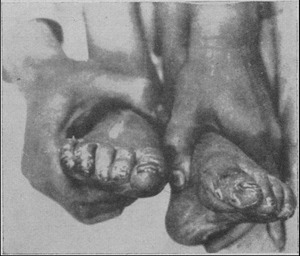Ergotism

Editor-In-Chief: Prab R Tumpati, MD
Obesity, Sleep & Internal medicine
Founder, WikiMD Wellnesspedia &
W8MD medical weight loss NYC and sleep center NYC
| Ergotism | |
|---|---|
 | |
| Synonyms | St. Anthony's Fire |
| Pronounce | N/A |
| Specialty | N/A |
| Symptoms | Convulsions, Gangrene, Hallucinations, Severe pain |
| Complications | Loss of limbs, Death |
| Onset | Hours to days after ingestion |
| Duration | Variable, depending on exposure |
| Types | N/A |
| Causes | Ingestion of ergot-contaminated grains |
| Risks | Consumption of rye or other grains infected with Claviceps purpurea |
| Diagnosis | Clinical evaluation, history of exposure |
| Differential diagnosis | Raynaud's phenomenon, Peripheral artery disease, Sepsis |
| Prevention | Proper storage and processing of grains |
| Treatment | Removal of contaminated food, Vasodilators, Pain management |
| Medication | N/A |
| Prognosis | Variable; can be fatal if untreated |
| Frequency | Rare in modern times |
| Deaths | N/A |
Ergotism is a condition that results from the long-term ingestion of products contaminated with the alkaloids produced by the Claviceps purpurea fungus that infects rye and other cereals, and more recently by the action of a number of ergoline-based drugs. It is also known as "St. Anthony's Fire", in reference to monks who cared for victims as well as symptoms, such as severe burning sensations in the limbs.
History[edit]
The first recorded epidemic of ergotism was in the Rhine Valley in 857 AD. Ergotism played a significant role in shaping the course of human history due to its effect on the health of those who consumed contaminated rye. Ergotism is also thought to be the cause of symptoms described in the Bible's book of Acts (Acts 2:13) and is a candidate for the cause of the dancing mania that occurred in Europe during the 14th-17th centuries.
Symptoms[edit]
Ergotism is characterized by hallucinations and sensations of burning in the limbs, the so-called "St. Anthony's Fire". These symptoms are due to the presence of a large group of alkaloid mycotoxins in the ergot fungus. Other symptoms can include fever, sweating, headache, mental impairment, and in severe cases, gangrene.
Treatment[edit]
Treatment of ergotism is primarily supportive, with removal of the source of ergot, usually by changing the diet. Vasodilators, anticoagulants, and heparin have been used to treat the vasoconstriction that is often a part of ergotism.
Prevention[edit]
Prevention of ergotism involves the careful monitoring of the cereal crops for the presence of the ergot fungus. The ergot bodies can be removed by winnowing or by flotation.
Images[edit]
-
Claviceps purpurea
-
Hordeum vulgare infected with Claviceps purpurea
See also[edit]
Ad. Transform your life with W8MD's Budget GLP-1 injections from $75


W8MD offers a medical weight loss program to lose weight in Philadelphia. Our physician-supervised medical weight loss provides:
- Weight loss injections in NYC (generic and brand names):
- Zepbound / Mounjaro, Wegovy / Ozempic, Saxenda
- Most insurances accepted or discounted self-pay rates. We will obtain insurance prior authorizations if needed.
- Generic GLP1 weight loss injections from $75 for the starting dose.
- Also offer prescription weight loss medications including Phentermine, Qsymia, Diethylpropion, Contrave etc.
NYC weight loss doctor appointmentsNYC weight loss doctor appointments
Start your NYC weight loss journey today at our NYC medical weight loss and Philadelphia medical weight loss clinics.
- Call 718-946-5500 to lose weight in NYC or for medical weight loss in Philadelphia 215-676-2334.
- Tags:NYC medical weight loss, Philadelphia lose weight Zepbound NYC, Budget GLP1 weight loss injections, Wegovy Philadelphia, Wegovy NYC, Philadelphia medical weight loss, Brookly weight loss and Wegovy NYC
|
WikiMD's Wellness Encyclopedia |
| Let Food Be Thy Medicine Medicine Thy Food - Hippocrates |
Medical Disclaimer: WikiMD is not a substitute for professional medical advice. The information on WikiMD is provided as an information resource only, may be incorrect, outdated or misleading, and is not to be used or relied on for any diagnostic or treatment purposes. Please consult your health care provider before making any healthcare decisions or for guidance about a specific medical condition. WikiMD expressly disclaims responsibility, and shall have no liability, for any damages, loss, injury, or liability whatsoever suffered as a result of your reliance on the information contained in this site. By visiting this site you agree to the foregoing terms and conditions, which may from time to time be changed or supplemented by WikiMD. If you do not agree to the foregoing terms and conditions, you should not enter or use this site. See full disclaimer.
Credits:Most images are courtesy of Wikimedia commons, and templates, categories Wikipedia, licensed under CC BY SA or similar.
Translate this page: - East Asian
中文,
日本,
한국어,
South Asian
हिन्दी,
தமிழ்,
తెలుగు,
Urdu,
ಕನ್ನಡ,
Southeast Asian
Indonesian,
Vietnamese,
Thai,
မြန်မာဘာသာ,
বাংলা
European
español,
Deutsch,
français,
Greek,
português do Brasil,
polski,
română,
русский,
Nederlands,
norsk,
svenska,
suomi,
Italian
Middle Eastern & African
عربى,
Turkish,
Persian,
Hebrew,
Afrikaans,
isiZulu,
Kiswahili,
Other
Bulgarian,
Hungarian,
Czech,
Swedish,
മലയാളം,
मराठी,
ਪੰਜਾਬੀ,
ગુજરાતી,
Portuguese,
Ukrainian




